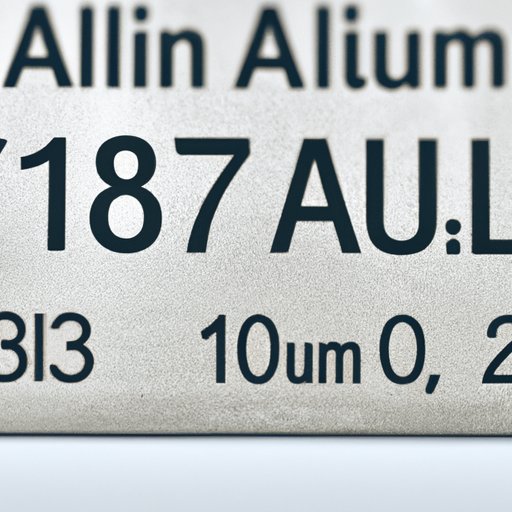Introduction
Aluminum is a metal with the atomic number 13, and its atomic symbol is Al. The atomic number is simply the number of protons in the nucleus of an atom. Understanding aluminum’s atomic number is crucial in modern science and technology, as it provides a foundation for studying its properties, reactions, and applications. This article will serve as a quick guide on aluminum’s atomic number, breaking down its significance and role in various areas of chemistry, materials science, and industry.
A Quick Guide to Aluminum’s Atomic Number
Aluminum’s atomic number is 13. It is determined by the number of protons in the nucleus of the atom. This means that any atom with 13 protons will be an aluminum atom. The number of neutrons can vary, leading to isotopes of aluminum with different atomic weights. The atomic number also determines the electron configuration of the atom, which influences its chemical reactivity and bonding behavior.
Exploring the Building Blocks of Aluminum
Atoms are the building blocks of matter. They consist of a nucleus containing protons and neutrons, surrounded by a cloud of electrons. Elements are formed when atoms of the same type are grouped together based on their atomic number. Aluminum is a metal that forms naturally in the earth’s crust, and it is the third most abundant element after oxygen and silicon. Its atomic structure plays a critical role in defining its properties and behavior.
The ABCs of Metals: Aluminum’s Atomic Number and the Periodic Table
The periodic table is a chart that arranges all known elements in order of their atomic number. This allows scientists to predict an element’s properties based on its position in the table. Aluminum belongs to the group of metals known as the “post-transition metals” and is located in group 13 or IIIA of the periodic table. Its atomic number determines its place in the table, which reflects its chemical and physical properties.
Breaking Down Aluminum: A Beginner’s Guide to its Atomic Number and Properties
Aluminum is a lightweight and corrosion-resistant metal that is widely used in various industries such as aerospace, automotive, construction, and packaging. Its high electrical and thermal conductivity make it ideal for electrical wiring and heat transfer applications. Understanding aluminum’s atomic number is crucial in explaining its properties such as its lightweight, strength, and corrosion resistance. Its atomic structure provides clues about its metallic bonding and reactivity, which explain its unique properties.

Unlocking the Power of Aluminum: Understanding the Role of its Atomic Number in Various Chemical Processes
Aluminum possesses unique chemical properties, mainly due to its reactivity. Its atomic number plays a vital role in its chemical behavior, as it determines its ability to form compounds and react with other elements. For example, aluminum can react with oxygen to form aluminum oxide, a stable compound that protects its surface from further corrosion. This property makes aluminum ideal for outdoor applications where exposure to environmental factors such as moisture and heat can cause metal degradation.
From the Big Bang to Modern Industry: Tracing the History of Aluminum’s Atomic Number
Aluminum has a long and fascinating history, starting from its discovery by ancient Greeks and Romans to its use in space exploration and modern industry. The development of the scientific study of atomic structure and atomic theory has helped humans understand the properties and structure of aluminum better. Today, aluminum’s atomic number plays a crucial role in various industries such as aerospace, automotive, construction, and packaging.
Mastering the Basics: Highlighting the Importance and Significance of Aluminum’s Atomic Number in Chemical Education
Chemical education is crucial in training the next generation of scientists and engineers. Understanding aluminum’s atomic number helps to deepen learners’ understanding of chemical bonding, structure, and reactivity. This knowledge is valuable in many fields such as materials science, engineering, and nanotechnology, where aluminum is used for various applications.
Conclusion
In conclusion, understanding aluminum’s atomic number is crucial in studying its properties and behavior. It is the foundation of modern science, technology, and industry. From its use in spacecraft to soda cans, aluminum’s atomic number plays a vital role in understanding its unique properties and applications.

